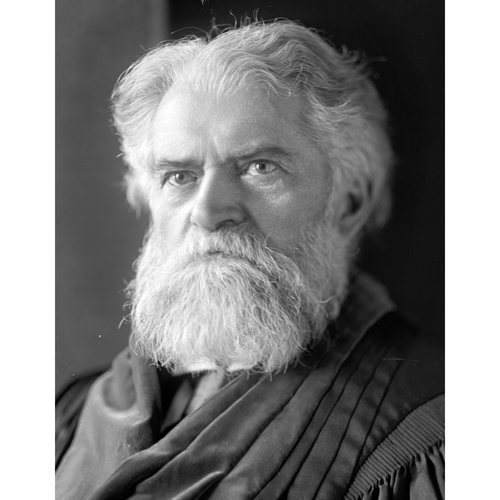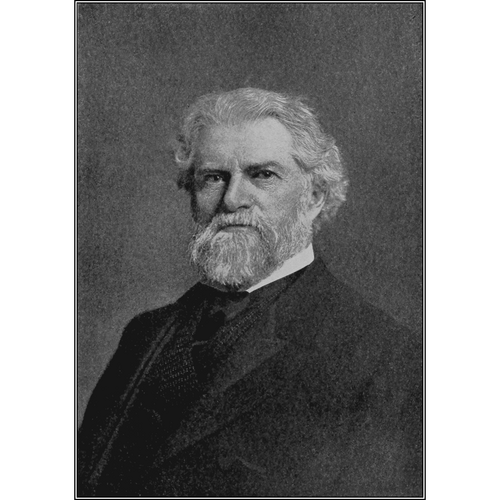
Source: Courtesy of Wikimedia Commons
NEWCOMB, SIMON, astronomer; b. 12 March 1835 in Wallace Bridge, N.S., eldest of the seven children of John Burton Newcomb and Emily Prince; m. 4 Aug. 1863 Mary Caroline (Mollie) Hassler in Washington, and they had three daughters; d. there 11 July 1909.
The Newcomb and Prince families had deep New England roots. John Newcomb was an innovative but desperately poor schoolteacher who moved the family to various parts of Nova Scotia and Prince Edward Island. Simon’s mother, also a teacher before her children were born, died when he was in his teens. He showed great precocity in mathematics and an interest in astronomy in his youth, but suffered a mental breakdown at about the age of seven and did not attend school regularly thereafter. When the family was at Clements (Clementsport), N.S. (1848–50), his father hired him out as a farm labourer in order to improve his physique and manual dexterity; he found the work distasteful. In 1851, during a visit to his maternal grandfather, “Squire” Thomas Prince, in Bend of Petitcodiac (Moncton), N.B., Simon was apprenticed to a local herbalist. After two years he realized that the doctor was a quack who would teach him nothing, and in September 1853 he fled on foot to Calais, Maine, and worked his passage to Salem, Mass. In later years he looked upon his childhood as an unhappy time spent in a backwater. None the less, he maintained contact with cousins in Nova Scotia, New Brunswick, and Ontario, travelling north on several occasions.
On arrival in Salem, Newcomb joined his father, who had moved earlier to seek a teaching position. Although largely self-educated, he was a teacher himself in Maryland during 1854 and 1855. In his leisure time he took up the study of mathematics and science with vigour. Newcomb’s contact with Joseph Henry, secretary of the Smithsonian Institution and America’s foremost physicist, led to further connections with the scientific community.
Henry was impressed by Newcomb’s intelligence and recommended him as a computer to the office of the American ephemeris and nautical almanac, a branch of the navy, in Cambridge, Mass. He was hired as a probationary employee in January 1857. That year he enrolled in the Lawrence Scientific School of Harvard University, where he encountered the noted astronomer Benjamin Peirce. He passed his examination for the degree sb summa cum laude on 16 July 1858. During the next three years he worked for the Almanac office and maintained his link with Harvard. In July 1860 he journeyed to Cumberland House (Sask.) in an unsuccessful attempt to observe a total solar eclipse.
In the early days of the Civil War, the United States Naval Observatory in Washington required new personnel, and Benjamin Apthorp Gould of the United States Coast and Geodetic Survey proposed that Newcomb go to Washington. He was appointed professor of mathematics on 27 Sept. 1861 and would remain at the observatory until his retirement in March 1897. Newcomb’s ideas had an enormous influence upon the observatory’s operations. Despite having little experience in observation, he reorganized the methods by which it was performed. Moreover, during 1873 and 1874 a 26-inch refractor was built and installed under his supervision, a feat that impressed his contemporaries and one which led to his direct involvement with the construction of large telescopes at the observatory in Pulkovo, Russia, and the Lick Observatory in California.
Newcomb’s greatest contribution to science, however, lay in his reorganization of the theory and means of computing lunar and planetary tables for the Nautical almanac. The base values employed by scientists in order to calculate lunar and planetary positions were subject to a great deal of variation, and Newcomb set to work to reduce them to order. His desire to reform the manner of calculating the positions had solidified before his arrival in Washington, and at the observatory he had quickly shown his mastery of the problems. In order to further his program he attempted to obtain the directorship of the Almanac office or the superintendency of the observatory. His appointment on 15 Sept. 1877 as director of the Almanac office – which had been moved to Washington – allowed him to effect the necessary changes. By the time he retired on 12 March 1897 his work had had an international impact.
From 1884 to 1894 and 1898 to 1900, Newcomb held a half-time professorship of mathematics at Johns Hopkins University in Baltimore, Md. During the years in Washington he published a steady stream of technical papers on celestial mechanics, popular books on science, novels, and books and articles on labour and economics. His wide interests also led him to become the first president of the American Society for Psychical Research (1885–87), and he attempted to bring scientific method and scepticism to that fashionable study. Although he had begun life as a fundamentalist Protestant, Newcomb later took a detached and philosophical view of his Christianity; he was, for example, disturbed by unreasoned religious attacks upon Darwinism.
Newcomb was a central figure in the most important scientific organizations. Elected to the National Academy of Sciences in 1869, he was its vice-president in 1883, and he was president of the American Association for the Advancement of Science between 1876 and 1878. He became an honorary member of several foreign academies and received many prestigious awards, such as the Copley Medal of the Royal Society of London, the gold medal of the Royal Astronomical Society, the Huygens Medal, awarded by the Dutch, and the Bruce Medal of the Astronomical Society of the Pacific. In addition, honorary doctorates were awarded him by a number of universities in North America and Europe. Recognized during his lifetime as the greatest American astronomer of the 19th century, he was also one of the world’s foremost scientists.
At the naval observatory, Newcomb had held the rank of captain, and in 1906 he was promoted rear admiral (retired). During his retirement he continued work upon the lunar tables and was president of the Congress of Arts and Sciences at the 1904 Louisiana Purchase exposition in St Louis, Mo.
A comprehensive bibliography of over 500 publications by Simon Newcomb was compiled by Raymond Clare Archibald and issued as “Simon Newcomb, 1835–1909: bibliography of his life and work,” in National Academy of Sciences, Memoirs (Washington), 17 (1924): 19–69.
Much of Newcomb’s most important technical work appears in the U.S., Nautical Almanac Office series, Astronomical papers prepared for the use of the “American ephemeris and nautical almanac” (Washington), 1 (1882)–9, pt.i (1912). He also contributed papers to the Smithsonian Institution’s Smithsonian Contributions to Knowledge (Washington), to the Astronomical Journal (Cambridge, Mass., etc.), and to the United States Naval Observatory’s Astronomical and meterological observations (Washington; commonly known as Washington observations) for 1865 and 1875.
Newcomb’s popular works include Popular astronomy (New York, 1878), The stars: a study of the universe (New York, 1901), and Astronomy for everybody; a popular exposition of the wonders of the heavens (New York, 1902), all of which went through numerous editions. He also wrote a variety of textbooks on mathematics and astronomy. His popular guides to economics include The ABC of finance; or, the money and labor questions familiarly explained to common people, in short and easy lessons (New York, 1877; another edition appeared there in 1878), Principles of political economy (New York, 1886), and A plain man’s talk on the labor question (New York, 1886).
Newcomb’s autobiography, The reminiscences of an astronomer, was published at Boston and New York in 1903. His papers are preserved in the Manuscript Div. of the Library of Congress, Washington.
W. W. Campbell, “Biographical memoir: Simon Newcomb, 1835–1909,” National Academy of Sciences, Memoirs, 17: 1–18. DAB. Dictionary of scientific biography, ed. C. G. Gillispie et al. (14v., New York, 1970–76), 10: 33–36. L. M. Dunphy, “Simon Newcomb: his contribution to economic thought” (phd thesis, Catholic Univ. of America, Washington, 1956). A. L. Norberg, “Simon Newcomb and nineteenth-century positional astronomy” (phd thesis, Univ. of Wis. – Madison, 1974); “Simon Newcomb’s early astronomical career,” Isis (Washington), 69 (1978): 209–25. Standard dict. of Canadian biog., vol.2.
Cite This Article
Richard A. Jarrell, “NEWCOMB, SIMON,” in Dictionary of Canadian Biography, vol. 13, University of Toronto/Université Laval, 2003–, accessed December 26, 2025, https://www.biographi.ca/en/bio/newcomb_simon_13E.html.
The citation above shows the format for footnotes and endnotes according to the Chicago manual of style (16th edition). Information to be used in other citation formats:
| Permalink: | https://www.biographi.ca/en/bio/newcomb_simon_13E.html |
| Author of Article: | Richard A. Jarrell |
| Title of Article: | NEWCOMB, SIMON |
| Publication Name: | Dictionary of Canadian Biography, vol. 13 |
| Publisher: | University of Toronto/Université Laval |
| Year of publication: | 1994 |
| Year of revision: | 1994 |
| Access Date: | December 26, 2025 |




